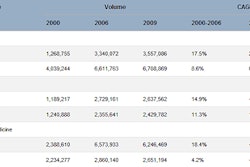The U.S. Centers for Medicare and Medicaid Services (CMS) is again targeting medical imaging for payment cuts. This time, the agency is proposing a 50% cut in the professional component of imaging studies performed on the same patient on the same day. The proposal is generating howls of protest from radiology advocates.
Under a proposed Medicare Physician Fee Schedule (MPFS) rule for 2012 released July 1, physicians would see a 50% payment reduction to Medicare's professional component (PC) for advanced imaging services, specifically CT, MR, and ultrasound. The proposal is similar to a cut already enacted five years ago to the technical component of imaging exams, which pays for the overhead costs involved in operating imaging equipment.
The radiology community has wasted little time criticizing the proposal, which some believe is more driven by budget-cutting goals than evidence regarding how radiologists practice medicine.
Too much efficiency?
The new proposed rule, called a multiple procedure payment reduction (MPPR), reflects CMS' belief that there are efficiencies in physician work. But it also indicates the agency's desire to reallocate costs from imaging to other services.
"The PC payment would be reduced by 50% for subsequent procedures furnished to the same patient, on the same day, in the same session," the agency said. "CMS estimates that this would reduce payments for these services by about $200 million, which would be redistributed to other services paid under the MPFS."
Medicare has had a longstanding policy to reduce payment by 50% for second and subsequent surgical procedures furnished to the same patient by the same physician on the same day, based on efficiencies in practice expense and pre- and postsurgical physician work, the agency wrote in the proposed rule.
In 1995, the MPPR policy, with the same percentage reduction, was extended to nuclear medicine diagnostic procedures, and the agency indicated that it would consider applying the policy to other diagnostic tests in the future. In 2006, the MPPR policy was extended to the technical component (TC) of certain diagnostic imaging procedures performed on contiguous areas of the body in a single session.
"We propose to expand the 50% payment reduction currently applied to the TC to apply also to the PC of the second and subsequent advanced imaging services furnished in the same session," the agency wrote in the proposed rule for 2012. "Full payment would be made for the PC and TC of the highest paid procedure, and payment would be reduced by 50% for the PC and TC for each additional procedure furnished to the same patient in the same session."
Radiology responds
Criticism of the proposal has been swift: On July 4, the American College of Radiology (ACR) released a statement condemning the cut, stating that "this unprecedented step would slash the reimbursement for physician interpretation and diagnosis."
CMS has once again not considered the evidence, according to Maurine Spillman-Dennis, senior director of economics and health policy for the ACR. Instead, the agency has latched on to recommendations offered by the Medicare Payment Advisory Commission (MedPAC), which are rooted in the mistaken belief that mispricing of diagnostic imaging services has led to overutilization.
"We are very upset, although we expected this to happen based on MedPAC's recommendation in February," Spillman-Dennis told AuntMinnie.com. "But MedPAC didn't assign a percentage number. CMS did, based on a precedent they've set for the reduction of global surgical services."
The proposal doesn't reflect how radiologists actually do their jobs, Spillman-Dennis said, and could have long-term repercussions in the Medicare program.
"If a patient comes in with multiple trauma and receives a CT and an MRI, those two exams have to be interpreted separately, but the radiologist will get paid only half of what the interpretation is worth for the second exam," she said. "We just don't think CMS' understanding of a physician's expected efficiency, or the duplication of physician work, is realistic. [If this goes through,] there will be some physicians who will say, 'Look, enough is enough. You've cut the technical component, and now you're cutting this. Maybe we'll stop offering advanced imaging.' "
What's more, the cuts are not based on evidence regarding the cost of imaging services, according to the ACR.
"These proposed cuts represent blind cost cutting," the ACR said in a statement. "Current payments to doctors for advanced imaging interpretations are an accurate reflection of the complexity of the process and should not be arbitrarily slashed. The time, intensity, and mental effort it takes to interpret an individual exam is relatively constant regardless of whether the patients' exams are interpreted separately or at the same session. Medicare should support such quality care and not repeatedly attempt to undermine it."
Opponents of the cut have also received some statistical backing for their argument. The Journal of the American College of Radiology published a study online June 29 ahead of print that analyzed the efficiencies that can be derived when imaging services are performed on the same patient by the same physician at the same time (JACR, June 29, 2011, pp. 1-7).
The study group found that time savings in terms of a percentage reduction in physician work varies greatly by modality, from 4.32% for CT to 8.15% for ultrasound, with a mean reduction of 5.87%. This is far less than the 50% reduction being proposed by CMS, and is less than the 25% MPPR rate recommended by the Government Accountability Office.
"When calculated in a systematic fashion, the maximum potential percent duplication for diagnostic imaging ranges from only 4% to 8%," the authors concluded.
And in other news ...
As things stand now, CMS projects a reduction of 29.5% to the conversion factor for 2012, based on the application of the sustainable growth rate (SGR) formula, which was adopted in the Balanced Budget Act of 1997. This would be the eleventh time the SGR formula called for a payment cut, according to CMS, although the cuts have been averted by legislative action every year except for 2002.
The agency did not address this reduction to the conversion factor in the current proposed rule, however, because President Barack Obama's budget submission for 2012 would extend current payment rates through December 31, 2013.
"This payment cut would have serious consequences and we cannot and will not allow it to happen," said Dr. Donald Berwick, administrator for CMS, in a statement. "We need a permanent SGR fix to solve this problem once and for all."
CMS is also proposing that it will continue to focus its efforts on identifying potentially misvalued codes across all specialties -- not just for cardiology, radiology, and nuclear medicine, as it has done in the past. It would also merge the comprehensive reviews of work and practice expense relative value units (RVUs) required by law every five years into this review process, the agency said.
Also in the rule, CMS proposes to undertake the following:
- Update a number of physician incentive programs, including the Physician Quality Reporting System (PQRS)
- Establish quality and cost measures to be used to reward physicians for providing higher quality and more efficient care
- Implement the third year of a four-year transition to new practice expense RVUs, based on data from the Physician Practice Information Survey that was adopted in the MPFS final rule for 2010
CMS is accepting comments on the proposed MPFS rule until August 30. A final rule will be issued November 1.
Lobbying campaign
Going forward, ACR plans to launch a grassroots effort to get its membership to lobby against the proposed MPPR cut, Spillman-Dennis said.
"We're going to be working with our members and radiology business managers, asking them to provide their own comments to CMS," she said. "The agency needs to know who exactly will be impacted by this change, and rather than just hearing our voice, it needs to hear from everyone who will be affected. We want CMS to see that we're not just making [our analysis of the negative impact of the rule] up."



















